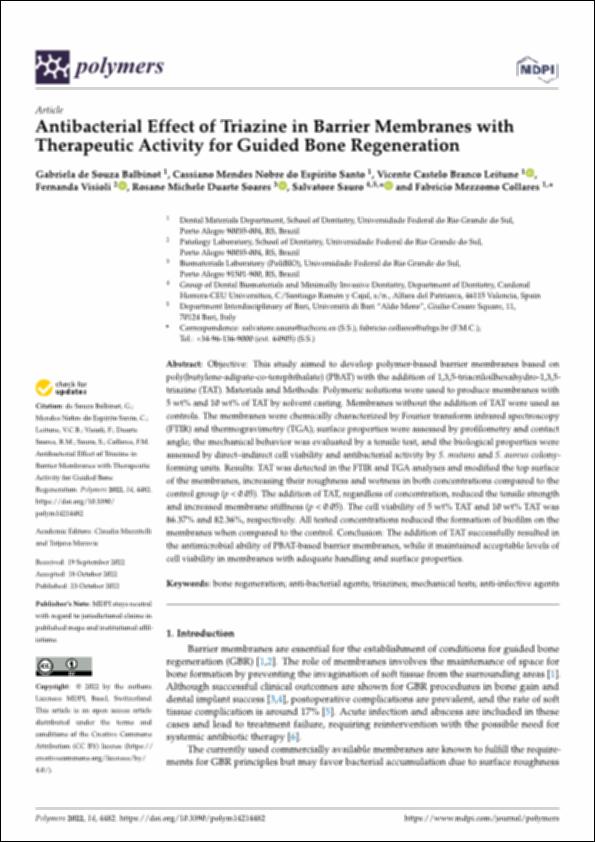Por favor, use este identificador para citar o enlazar este ítem:
http://hdl.handle.net/10637/14362Antibacterial effect of triazine in barrier membranes with therapeutic activity for guided bone regeneration
| Título : | Antibacterial effect of triazine in barrier membranes with therapeutic activity for guided bone regeneration |
| Autor : | Souza Balbinot, Gabriela de Espírito Santo, Cassiano Mendes Nobre do Leitune, Vicente Castelo Branco Visioli, Fernanda Duarte Soares, Rosane Michele Sauro, Salvatore. Collares, Fabrício M. |
| Materias: | Dental therapeutics.; Polymers in Dentistry.; Germicides.; Bones - Regeneration.; Terapéutica dental.; Polímeros - Aplicaciones en Odontología.; Huesos - Regeneración.; Bactericidas. |
| Editorial : | MDPI |
| Citación : | de Souza Balbinot, G., Mendes Nobre do Espírito Santo, C., Leitune, V. C. B., Visioli, F., Duarte Soares, R. M., Sauro, S. & Collares, F. M. (2022). Antibacterial effect of triazine in barrier membranes with therapeutic activity for guided bone regeneration. Polymers, vol. 14, i. 21 (23 oct.), art. 4482. DOI: https://doi.org/10.3390/polym14214482 |
| Resumen : | Objective: This study aimed to develop polymer-based barrier membranes based on poly(butylene-adipate-co-terephthalate) (PBAT) with the addition of 1,3,5-triacriloilhexahydro-1,3,5- triazine (TAT). Materials and Methods: Polymeric solutions were used to produce membranes with 5 wt% and 10 wt% of TAT by solvent casting. Membranes without the addition of TAT were used as controls. The membranes were chemically characterized by Fourier transform infrared spectroscopy (FTIR) and thermogravimetry (TGA); surface properties were assessed by profilometry and contact angle; the mechanical behavior was evaluated by a tensile test, and the biological properties were assessed by direct–indirect cell viability and antibacterial activity by S. mutans and S. aureus colonyforming units. Results: TAT was detected in the FTIR and TGA analyses and modified the top surface of the membranes, increasing their roughness and wetness in both concentrations compared to the control group (p < 0.05). The addition of TAT, regardless of concentration, reduced the tensile strength and increased membrane stiffness (p < 0.05). The cell viability of 5 wt% TAT and 10 wt% TAT was 86.37% and 82.36%, respectively. All tested concentrations reduced the formation of biofilm on the membranes when compared to the control. Conclusion: The addition of TAT successfully resulted in the antimicrobial ability of PBAT-based barrier membranes, while it maintained acceptable levels of cell viability in membranes with adequate handling and surface properties. |
| Descripción : | Este artículo se encuentra disponible en la siguiente URL: https://www.mdpi.com/2073-4360/14/21/4482 Este artículo de investigación pertenece al número especial "Polymers Strategies in Dental Therapy". |
| URI : | http://hdl.handle.net/10637/14362 |
| Derechos: | http://creativecommons.org/licenses/by/4.0/deed.es |
| ISSN : | 2073-4360 (Electrónico) |
| Idioma: | es |
| Fecha de publicación : | 23-oct-2022 |
| Centro : | Universidad Cardenal Herrera-CEU |
| Aparece en las colecciones: | Dpto. Odontología |
Los ítems de DSpace están protegidos por copyright, con todos los derechos reservados, a menos que se indique lo contrario.


